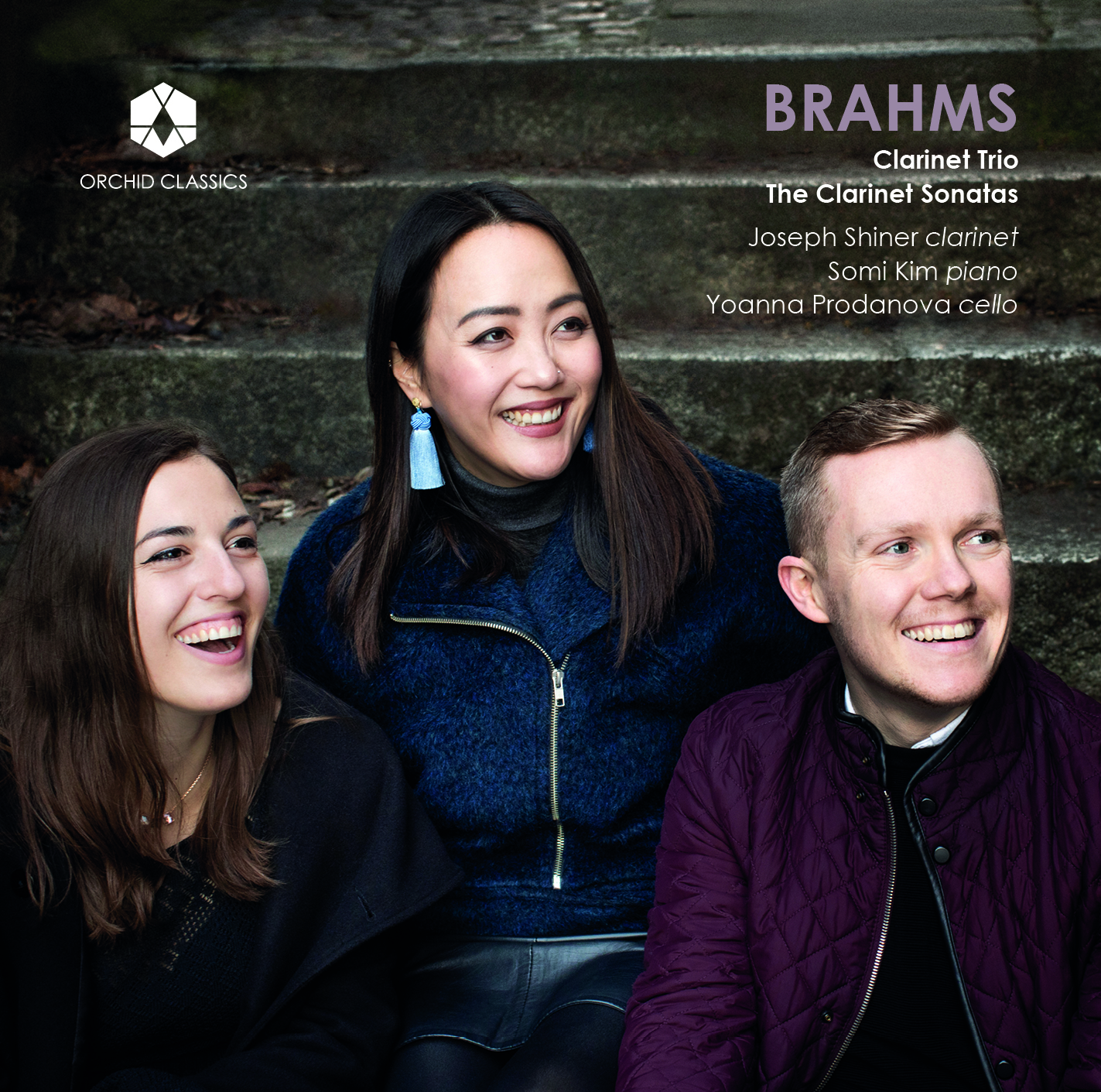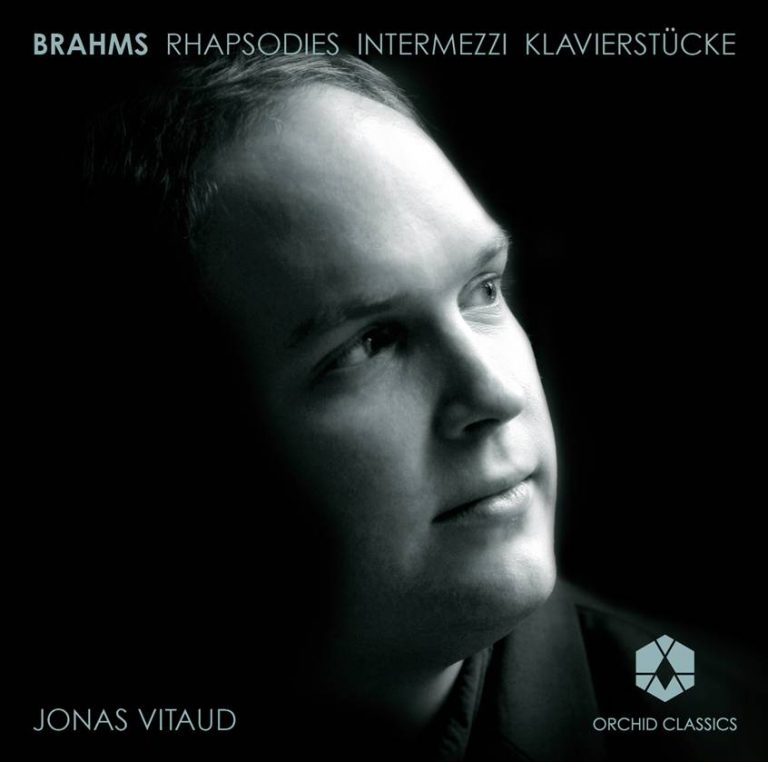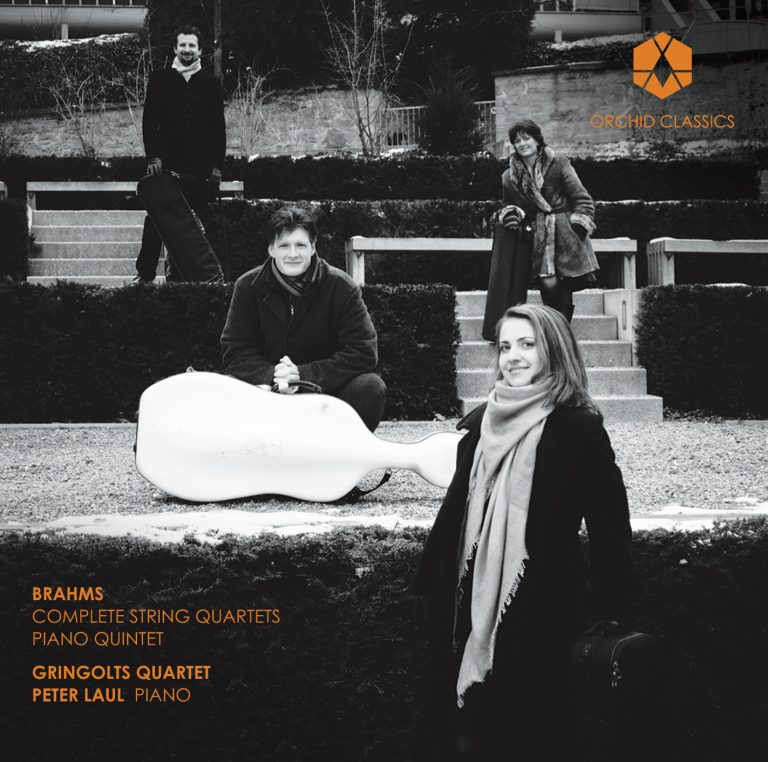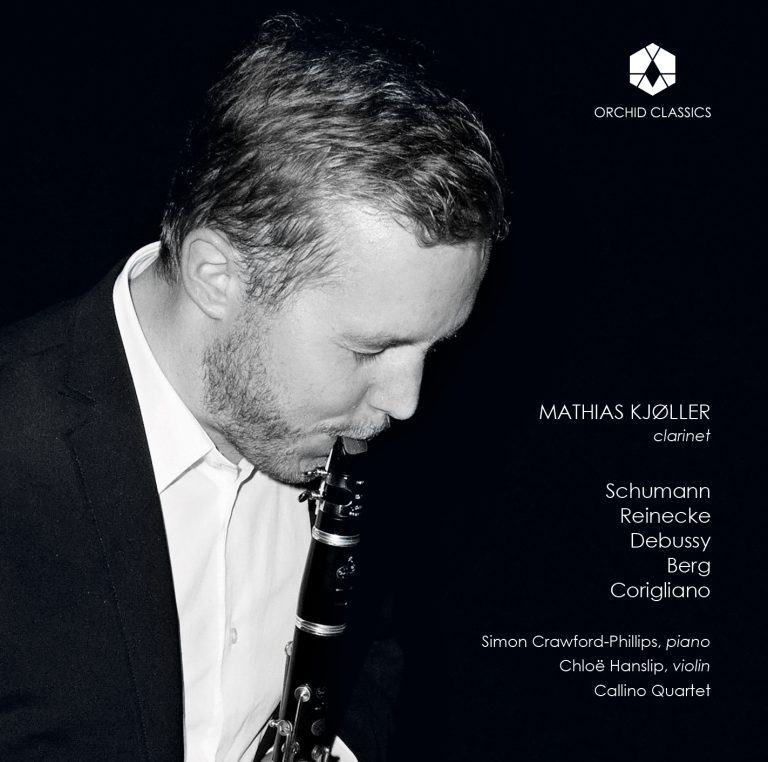Artist Led, Creatively Driven

BRAHMS
Joseph Shiner, clarinet
Somi Kim, piano
Yoanna Prodanova, cello
Release Date: July 5th 2019
ORC100099
JOHANNES BRAHMS (1833 – 1897)
Clarinet Trio
The Clarinet Sonatas
Trio for clarinet, violoncello and piano in A minor, Op.114
1 Allegro 7.42
2 Adagio 7.09
3 Andantino grazioso 4.29
4 Allegro 4.28
Sonata for clarinet and piano in F minor, Op.120 No.1
5 Allegro appassionato 7.50
6 Andante un poco adagio 4.50
7 Allegretto grazioso 4.16
8 Vivace 5.08
Sonata for clarinet and piano in E flat major, Op.120 No.2
9 Allegro amabile 7.50
10 Allegro appassionato 5.05
11 Andante con moto – Allegro 6.41
Total time 65.28
Joseph Shiner, Clarinet
Somi Kim, Piano
Yoanna Prodanova, Violoncello
‘Joachim has sacrificed the virginity of his Quartet for my newest things’; so wrote Brahms to his friend, the critic Eduard Hanslick, on 1 December 1891. He went on to explain that, hitherto, Joachim had ‘carefully protected the chaste sanctuary but now, in spite of all my protestations, he insists that I invade it with clarinet and piano, with trio and quintet’, adding that ‘this will take place on 12 December, and with the Meiningen clarinettist’.
The renowned Hungarian violinist, Joseph Joachim, had founded his string quartet in 1869 and with it, for many years thereafter, was to give concerts at the Berlin Singakademie. Until Brahms invaded ‘the holy circle’ (as he also called it) Joachim’s concert series had been restricted entirely to music for strings. The Meiningen clarinettist, who, with Brahms, led this invasion was Richard Bernhard Herrmann Mühlfeld.
Born on 28 February 1856 in the German spa town of Salzungen, the young Mühlfeld grew up in a highly musical family. His father, Leonhard, who played the violin, trumpet and double bass, also led a small orchestra in which he expected his four sons to play as soon as they were able. Like his elder brothers, Richard learnt to play several instruments, in his case the piano, the violin and the clarinet (on which it seems he was practically self-taught) and also sang in the local church choir.
In 1873, at the age of seventeen, Richard went to Meiningen to join his brother, Martin, who was by then a member of the Court Orchestra there. Some twenty-five miles south of Salzungen, Meiningen was then the capital of the Duchy of Saxe-Meiningen and it was to be Mühlfeld’s home for the rest of his life. When he first joined the orchestra it was as a violinist, but before long his expertise on the clarinet had been noted and resulted in him first deputising occasionally for the orchestra’s clarinettist, Wilhelm Reif, and then taking over from him in 1879. Reif, who was also the orchestra’s musical director, composed a concerto for Mühlfeld which had its first performance on Christmas Day 1885. Five years later Rief died and the post of musical director went to Mühlfeld.
It was in March 1891, while he was visiting Meiningen, that Johannes Brahms first encountered Mühlfeld. Having heard him play Weber’s first clarinet concerto and the clarinet quintet by Mozart, Brahms was entranced by Mühlfeld’s playing and announced, there and then, that he would postpone his intended retirement as a composer and write some chamber pieces that this new friend could add to his repertoire. As he told Clara Schumann, widow of the composer Robert, ‘nobody can blow the clarinet more beautifully than Herr Mühlfeld’. Brahms was soon referring to Mühlfeld as ‘the nightingale of the orchestra’ and amusing himself by introducing him to his friends as Fräulein von Mühlfeld, meine Primadonna or, more simply, as Fräulein Klarinette.
As was his wont, Brahms spent the summer of 1891 at Bad Ischl, a spa town in the Salzkammergut east of Salzburg, and it was there that he began to compose two of the pieces he had promised to write for Mühlfeld. These were the Trio in A minor, Op.114 and the Quintet in B minor, Op.115. By the time his holiday was over, Brahms had completed both of these works and was eager to hear them played by Mühlfeld. However, it was not until November that Brahms was back in Meiningen to prepare these new works for their first performances.
These were to take place in the private apartments of Georg, the second Duke of Saxe-Meiningen, and his wife, Baroness von Heldburg, and rehearsals for the Trio began on 21 November. Mühlfeld, of course, was to play the clarinet part that had been written for him, with Brahms at the piano and Robert Hausmann, a member of the Joachim Quartet, playing the cello. Rehearsals for the Quintet, however, could not begin until Joachim arrived from Berlin on 24 November, the day of the concert.
While only a selected audience attended this event, even the rehearsal for the official premiere of the two works in Berlin on 12 December was open to the public. At both rehearsal and concert, the musicians received a tremendous ovation and encores were demanded. For Mühlfeld it was the great turning point in his career as he was soon to become the most sought-after clarinettist of his day. Before long he was playing these works in Vienna, again with Brahms taking the piano part in the Trio and then, in March 1892 at Joachim’s insistence, he found himself playing them in London. As Brahms would never agree to cross the English Channel, he could only learn of their success by means of a telegram sent to him by Joachim immediately after the concert.
During his summer holidays at Bad Ischl in 1892 and 1893, Brahms concentrated on composing solo piano music but the following year he set about writing two more works for Mühlfeld. These were the sonatas for clarinet and piano and they were tried out for the first time at Duke Georg’s summer palace near Berchtesgaden on 19 September 1894. Two months later Brahms and Mühlfeld were to play these new works to Clara Schumann at her home in Frankfurt, having first sent her a tuning fork so that her piano could be tuned to the pitch favoured by the clarinettist. Clara was delighted with the sonatas and was subsequently to play them herself with Mühlfeld. They received their first public performances at a concert in Vienna on 7 January 1895.
The Trio is in four movements, the first of which opens with a theme Brahms had originally intended for inclusion in a fifth symphony he was never to write. Like the Trio, the F minor sonata has four movements but the E flat major only has three, the third being in the form of a theme and variations. It is said that Brahms tended to claim that these two sonatas were for ‘piano and Mühlfeld’ but the published score more prosaically describes them as being for ‘piano and clarinet (or viola)’.
Peter Avis, February 2019
‘Time mitigates. Death transfigures.’
Brahms, in a letter to Julius Allgeyer
When I was asked if I would undertake this project, I accepted immediately. Having already explored and performed the sonatas extensively throughout my studies, not only did I feel reassuringly familiar with their qualities and challenges, but I also appreciated their seemingly limitless nuances, as well as the joy of continually discovering new interpretative possibilities within them. Yet this sense of excitement was soon accompanied by a feeling of apprehension. The transient nature of live performance allows for experimentation and risk-taking, but the prospect of documenting my interpretation in a far more permanent way seemed like a challenge for which I felt far from ready.
In part, my anxiety related to the impression that I had inherited of Brahms and his music. The image of the uncompromisingly serious composer, whose music married cerebral technical complexities with an expressive range that ran the gamut of human emotion, was a daunting one (albeit with more than a kernel of truth within it!). This idea only seemed to intensify when considering music from late in his life, a time of personal tragedy and ailing health. And yet, whilst I recognised this image of Brahms in so much of his late music (in particular the late piano pieces), I felt an instinctive disconnect between this popular perception of the composer and the general affekt of the clarinet chamber music.
As part of my preparations, therefore, I looked into Brahms’correspondence from the last decade of his life, during which time all the chamber works for clarinet were written. I’m not sure exactly what I expected to encounter in these letters –perhaps a series of meditations on life, death, or even musings on the nature of his musical evolution. I certainly assumed a distinctly ‘autumnal’tone, an adjective which is so often applied to the music of this period, would emerge in his writing. Instead, what I saw was a portrait of a man with a palpable zest for life. Enthusiastic about performances of his own music, as well as the works of his colleagues such as Dvořák, he was also strikingly modest and unfailingly kind, most poignantly to the children of Clara Schumann upon her death, only months before his own. The warmth present in the letters belies the bereavements he suffered during these years, even during the onset of his final illness – as he writes in his final letter to his stepmother Karoline, only a few days before his death: ‘For the sake of a change I have lain down for a while and writing is therefore uncomfortable. Apart from that have no fear, nothing has changed and as usual, all I need is patience.’
With regard to the clarinet works themselves, Brahms talks very little of his feelings towards them. The very fact that his compositional vigour was rekindled by the artistry of Richard Mühlfeld points to a sense of renewed youth and energy, and yet the recurring theme in his letters is that of triviality. Barely mentioning the Trio at all, he refers to the sonatas in a letter to Joseph Joachim as ‘undemanding’, and in a typically self-deprecatory gesture to his publisher Simrock, in anticipation of a musical gathering with Mühlfeld hosted by a Dr. Abraham, he muses: ‘Well, I don’t suppose you want two clarinet sonatas, and should I forget my fine resolution, I am surely entitled to give them to Dr. Abraham as a farewell present.’
These discoveries made me realise something about Brahms: that he was capable of youthfulness and lightness despite his advancing age, and that, following his own example, his music might not always be taken quite so seriously. This project proved to be a golden opportunity to transfigure Brahms in my own imagination, and the time spent becoming more intimate with him as a nuanced figure, more complex than his reception history has so often suggested, mitigated any anxieties I thought I would experience in recording the music. Exploring these masterpieces with two of my most cherished friends has been incredibly joyful, and I hope this recording captures something of the convivial spirit in which they were created.
Joseph Shiner, February 2019
JOSEPH SHINER CLARINET
Clarinettist Joseph Shiner is active in concert around the United Kingdom and internationally as a soloist, having performed at venues and festivals including the Wigmore Hall, Cadogan Hall, St. Martin in the Fields, and St. John’s Smith Square, Barbican Centre, and the Royal Albert Hall. He is the recipient of numerous prizes including the Hattori Foundation Senior Award, the Making Music Philip and Dorothy Green Award for Young Concert Artists, the Worshipful Company of Musicians Prince’s Prize and the Royal Academy of Music’s Buffet Crampon Clarinet Prize. A selected artist for Making Music and the City Music Foundation, he is currently Artist-in-Residence at Lancing College, and was featured as BBC Music Magazine’s ‘Rising Star’ in August 2016.
Joseph made his London solo debut with the Cambridge University Symphony Orchestra at St. John’s Smith Square in 2011. He has collaborated with pianists Somi Kim, Ashley Fripp and Edward Liddall, ensembles such as Maiastra and the Endellion Quartet, as well as broadcasting on Radio 3. He is a founding member of the wind chamber group Magnard Ensemble, who hold awards from the Tillett, Tunnell and CAVATINA Trusts. As an orchestral musician, Joseph has performed with, among others, the Orchestra of the Royal Opera House, BBC Concert Orchestra, London Contemporary Orchestra and Aurora Orchestra.
Joseph’s initial studies took place at Wells Cathedral School with Kevin Murphy and Timothy Orpen. After reading Music at Gonville and Caius College, Cambridge University, graduating with First Class honours and several awards and prizes, he moved to postgraduate study with Angela Malsbury, Mark van de Wiel and Chi-Yu Mo at the Royal Academy of Music, London, where he graduated with Distinction and the DipRAM for an outstanding final recital. He has subsequently undertaken private study with Patrick Messina, Andrew Marriner and Christopher Richards.
www.josephshiner.co.uk
@josephshiner
SOMI KIM PIANO
South Korean-born New Zealand pianist Somi Kim has established herself as one of today’s most highly regarded young pianists with a string of competition successes and extensive concert experience.
Somi graduated from the Royal Academy of Music with an Advanced Diploma in Performance and Master of Arts with Distinction, receiving the HRH Princess Alice the Duchess of Gloucester’s Prize, a DipRAM and the Christian Carpenter Prize for the Best Recital. Somi has received the Royal Over-Seas League Accompanist Prize, the Gerald Moore Award for Accompanists, AESS Patricia Routledge National English Song Accompanist Prize, Mozart Singing Competition Accompanist Prize, Bromsgrove International Musicians Competition Accompanist Prize, Vivian Langrish Memorial Trust Prize, Thomas Art of Song Accompanist Prize, Major van Someron-Godfery Prize for Accompanists, Concordia Serena Nevill and Barthel Prizes and the 6th Pettman/Royal Over-Seas League Arts International Scholarship.
Sought after as a chamber musician, song accompanist and répétiteur, Somi is an artist for the Kirckman Concert Society, Park Lane Group, Concordia Foundation and is a Yeoman of the Worshipful Company of Musicians. Somi is a scholar on the Britten-Pears Young Artist Programme and Georg Solti Accademia. She is an official pianist at the International Holland Music Sessions, International Vocal Competition ’s-Hertogenbosch, Gisborne International Music Competition and the Samling Institute. Somi has recently been appointed as the pianist for NZTrio, an ensemble that is recognised as a ‘national treasure’ and as ‘New Zealand’s most indispensable ensemble’. In recital, Somi’s appearances include Het Concertgebouw, Slovak Philharmonic, Wigmore Hall, Royal Opera House, St. John’s Smith Square, Cadogan Hall, Bridgewater Hall and the Edinburgh Fringe, Ryedale, Endellion and Oxford Lieder Festivals.
www.somikim.com
@somikimpianist
YOANNA PRODANOVA VIOLONCELLO
Cellist Yoanna Prodanova was born in Bulgaria in 1992. She moved to Canada in her early teens before starting her studies at the Conservatoire de Montréal with Denis Brott and obtaining a Diplôme d’études Supérieures (with highest honours). She completed her Bachelors and Masters degrees at the Guildhall School of Music and Drama (funded by the Guildhall Trust, Frost Trust and Help Musicians UK) with Louise Hopkins, Richard Lester and Rebecca Gilliver before continuing her studies at the Royal Academy of Music with Hannah Roberts on the prestigious Advanced Diploma course as a Bicentenary Scholar in 2018. Yoanna is recipient of the 2016 Philip and Dorothy Green Award for Young Artists, as well as the Sylva Gelber Award for two consecutive years.
She regularly performs in the UK, Europe and Canada and has appeared in such venues as Wigmore Hall, Milton Court and Barbican Hall, Casa de Musica Porto and Tonhalle Zürich. Her festival appearances include recitals in St Magnus, Buxton and Harrogate festivals, as well as chamber music in Siete Lagos (Argentina), Alderney and Newbury Festivals, among others. She has also participated in IMS Prussia Cove, Music Academy of the West, London Masterclasses, Banff and Kronberg Festival. Her performances have been broadcast on BBC Radio 3, CBC Radio 1 and Medici TV.
A dedicated chamber musician, Yoanna is the cellist of the Barbican String Quartet who made their Wigmore Hall debut in 2017 as part of the Maisie Lewis Award, and regularly collaborates with pianist Mihai Ritivoiu with whom she will be recording her first solo album, comprising works by Chopin, Janáček and Fauré in ٢٠١٩. Yoanna plays on a 1788 Giuseppe Gagliano ‘cello generously loaned to her by the Canimex Group.
www.yoannaprodanova.com
@YoannaProdanova









